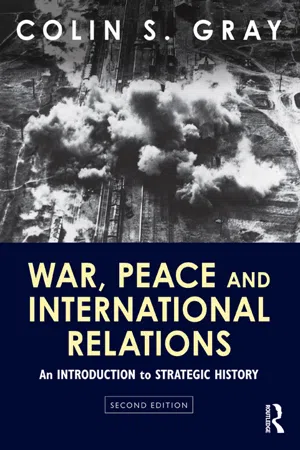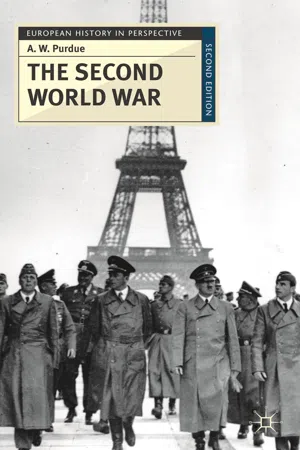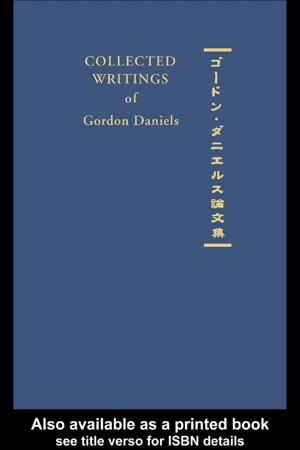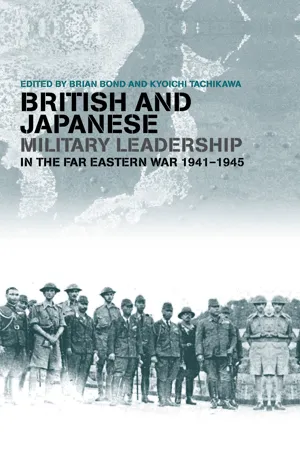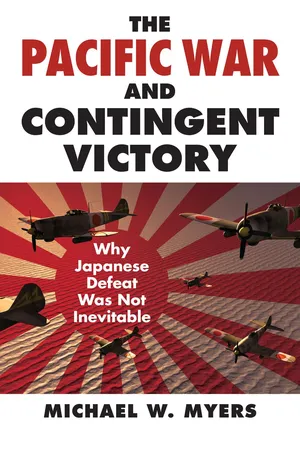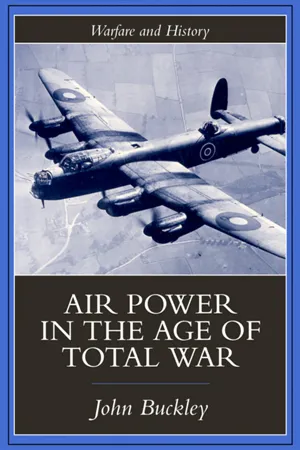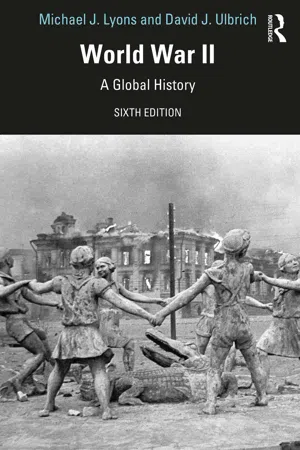History
War Against Japan
The "War Against Japan" refers to the military conflict between Japan and various Allied powers during World War II, primarily from 1941 to 1945. This war included significant naval battles in the Pacific, such as the Battle of Midway and the island-hopping campaigns, as well as intense ground fighting in places like Guadalcanal and Okinawa. The war ultimately ended with Japan's surrender following the atomic bombings of Hiroshima and Nagasaki.
Written by Perlego with AI-assistance
Related key terms
9 Key excerpts on "War Against Japan"
- eBook - ePub
War, Peace and International Relations
An introduction to strategic history
- Colin S. Gray(Author)
- 2013(Publication Date)
- Routledge(Publisher)
12 World War II in Asia–Pacific, I
Japan and the politics of empireReader's guide: The connections between the two wars. The growth of the Japanese Empire. US–Japanese relations and the approach to war.Introduction: global war
In its origins, stakes and purposes, the war in Asia–Pacific was all but entirely unrelated to the war in Europe. Nevertheless, it is still accurate, if strangely so, to regard the War Against Japan as an integral part of World War II. The principal connection between the two wars, half a world apart, was that it was only the ongoing war in Europe that emboldened Japan to seek a grand military solution to its strategic problems. Had there been no active conflict in Europe, Japanese prospects for success would have been so poor that war against the European colonial powers and the United States almost certainly would have been rejected as the policy choice. Even as it was, in 1941 Japanese leaders were far from united in a determination to fight. Context is vital. In 1940–1, as Japan's material strategic condition worsened because of American-led economic sanctions, so the radical changes in the global strategic context effected by Germany's victories appeared to offer a unique opportunity for Japan to exploit.It is useful to draw attention to an obvious political difference between the war in Europe and that in Asia–Pacific. Certainly by 1939, probably after 1936, or even as early as 1933, with hindsight it is plausible to argue that war in Europe was unavoidable. Germany, which is to say Adolf Hitler, wanted war. He might briefly be deterred tactically, but not strategically or politically. By contrast, Japan did not want war with the United States, though war with the British and the Dutch was unavoidable, given Tokyo's need for reliable access to the raw material resources (especially oil and rubber) of South East Asia. It should have been possible to coerce by menaces, perhaps even to persuade Japan not to embark on the inherently extremely hazardous course of war. But for a potential combatant to agree to be deterred when the stakes are perceived to be of the highest order, it must be deprived of any hope of military success. Also, it should be offered a politically tolerable alternative to war. In 1941, alas, those crucial conditions did not apply, as the world learned on 7 December, when the Imperial Japanese Navy attacked Pearl Harbor. - eBook - ePub
The United States in World War II
A Documentary History
- Mark Stoler, Molly Michelmore(Authors)
- 2018(Publication Date)
- Hackett Publishing Company, Inc.(Publisher)
Chapter 5 The War Against Japan—and the JapaneseThe War Against Japan differed in many ways from the war against Germany. Inter-service disagreements about the relative importance of ground, naval, and air operations admittedly took place in both conflicts, but those regarding Asia and the Pacific were quite different from those regarding Europe. So were Allied political disagreements and the nature of the actual fighting.Despite official maintenance of the Germany-first strategy enunciated before U.S. entry into the war and reaffirmed soon after Pearl Harbor (see Chapter 3), the United States sent major forces to the Pacific in 1942 in an effort to halt the numerous Japanese offensives that followed the attack on Pearl Harbor. Such an effort was demanded by the Chinese, Australian, and New Zealand governments, by the U.S. Navy, by Philippine Commander General Douglas MacArthur, and by an American public desirous of immediate revenge for the Pearl Harbor attack. Consequently, by the end of 1942, and even through much of 1943, more U.S. forces were deployed against Japan than against Germany. Those forces did not succeed in preventing Japanese conquest of the Philippines, Burma, the Dutch East Indies, Malaya, and all the other European colonies in Southeast Asia by the spring of 1942, but they did halt additional Japanese offensives in the May–June 1942 naval Battles of Coral Sea and Midway and the lengthy six-month campaign that began in August for control of the island of Guadalcanal in the South Pacific Solomon Islands chain. Yet the Japanese still possessed in 1943 one of the largest empires in history, and how to defeat them became a matter of intense inter-service and inter-Allied dispute.Reversing the precision bombing strategy they championed in the war against Germany, U.S. military planners came to favor the eventual area bombing of Japanese cities. How to get within bombing range of those cities, however, and whether bombing alone would be sufficient to obtain Japanese surrender, led to major debates over the relative importance of different geographic areas and types of forces to be used. - eBook - ePub
- A. W. Purdue(Author)
- 2011(Publication Date)
- Bloomsbury Academic(Publisher)
A World War?The Origins of the Far Eastern War
What gives the Second World War its claim to have been a world war in a more complete sense than the First World War is the involvement of Japan. The Japanese attack upon the US fleet at Pearl Harbor can be seen to have made a European war a world war. There are, however, a number of problems with this essentially Eurocentric perspective.From an American point of view, the Second World War can be seen as beginning in December 1941, while from an East Asian, especially a Chinese, viewpoint, that date marked merely an extension of a Sino-Japanese war that had been going on since at least 1937. Even the terms ‘World War II’ or ‘Second World War’ are not always used. Americans usually refer to ‘the Pacific War’, though often to ‘World War II in the Pacific’, but this puts the emphasis upon the war between the USA and Japan, thus neglecting the fighting in East Asia and particularly China. The Japanese referred during the war to ‘the Greater East-Asian War’ while the term ‘the Far Eastern War’ has recently found favour among British historians.1Such terminological controversy raises the fundamental question as to how far the war in the Far East and the Pacific was linked to the war in Europe, and to what extent it should be considered a separate conflict. For the British Empire and the USA the links are obvious, their armed forces fought both in the European war and against Japan. For the Dutch and the French there were at least parallels for, just as they were defeated and occupied by Germany, so their headless colonies were overrun by the Japanese. For the Axis powers there was an alliance and plans for co-operation, but little harmonisation of strategy or practical mutual assistance. The Soviet Union, which had clashed with Japan in 1938 and 1939, enjoyed a wary neutrality in the war between Japan and the Western allies until its opportunist declaration of war upon Japan in 1945. In many ways we can conceive of two wars, bridged by the participation in each of Britain and the US. - eBook - ePub
- Gordon Daniels(Author)
- 2004(Publication Date)
- Routledge(Publisher)
Power and Culture, The Japanese American War, 1941–1945 (Harvard University Press, 1981); Richard H.Minear, Victors’ Justice, The Tokyo War Crimes Trial (Princeton University Press, 1971); Robert A.Scalapino, Democracy and the Party Movement in Prewar Japan, The Failure of the First Attempt (University of California Press, 1962); Ben-Ami Shillony, Politics and Culture in Wartime Japan (OUP, 1980); Kenneth R.M.Short, (ed) Film and Radio Propaganda in World War II (Croom Helm, 1983).Passage contains an image
First published in Sir Hugh Cortazzi and Gordon Daniels (eds), Britain and Japan 1859–1991 Themes and Personalities, London, Routledge, 1991, pp. 277–288, 313–31437
Sir George Sansom (1883–1965): Historian and Diplomat
AMONG British historians whose minds and senses have engaged Japan's rich civilization Sir George Sansom remains pre-eminent. Sixty years after the publication of his Japan A Short Cultural History and a quarter of a century after the completion of his History of Japan, these works remain classics of grace and rigour which set exacting standards for each generation of western scholars.1 Yet Sir George Sansom was far more than a historian of formidable and subtle powers. He was a long-serving diplomat, linguist and aesthete who overcame illness and disappointment with epic patience and resolve.George Bailey Sansom was born in Limehouse on the eastern fringe of London on 23 November 1883. His father was a naval architect who lost most of his savings by investing, unwisely, in his employer's company. As a result Sansom was never to study at a British university and regretted this intellectual loss to the end of his life. Yet within these relatively straitened circumstances Sansom received an education which heightened his cultural sensitivity and refined his linguistic skills.2 - eBook - ePub
- R. Cargill Hall(Author)
- 2020(Publication Date)
- Barakaldo Books(Publisher)
4—Strategic Bombing in the Pacific 1942-1945
Alvin D. CooxDuring the 1920s and 1930s, military leaders on both sides of the Pacific Ocean could agree, at least implicitly, that in some unspecified future, hostilities between the United States and Japan were a distinct possibility. Indeed, the U.S. Navy based most of its fleet in the Pacific because of “the unspoken conviction of every senior naval officer that the next war would be with Japan, the only maritime power likely on any near or remote contingency to challenge the United States.”{655} In Japan as early as 1921, a retired Army lieutenant general, Kōjirō Satō, published a widely read treatise, If Japan and America Fight . In it he claimed that America posed a “threat” to Japan’s existence comparable to the threat posed by the Mongolian forces of Kublai Khan in the 13th century and those of Tsarist Russia in 1904.{656}Other hypothetical national enemies, however, demanded consideration in American and Japanese contingency planning and diffused the strategic priorities. Thus, in the 1930s, the attention of the American government in general, and of the U.S. Army in particular, was increasingly riveted on the Nazi Third Reich and Europe, not on Japan and the Pacific. This focus of attention would underlie a decision by U.S. leaders, even after the Japanese attack on Pearl Harbor, to pursue a “Germany-first” military strategy in World War II.{657}Passage contains an image
The Japanese and American Dimension
For its part, the Imperial Japanese Army (IJA) envisaged fighting enemies that differed from those confronting its sister service, the Imperial Japanese Navy (IJN). The IJA’s traditional foes were nearby continental land powers, primarily the Soviet Union and China. The IJN’s hypothetical enemies, after the fateful sundering of the Anglo-Japanese alliance in the early 1920s, were two first-class but distant naval and maritime powers: Britain and the United States.{658} - Brian Bond, Kyoichi Tachikawa, Brian Bond, Kyoichi Tachikawa(Authors)
- 2004(Publication Date)
- Routledge(Publisher)
4 LEADERSHIP IN JAPAN’S PLANNING FOR WAR AGAINST BRITAIN
Kanji Akagi
Introduction
The Second World War saw what were, at root, unrelated wars in Asia and in Europe being fought as one. This situation developed in one fell swoop with Japan’s attack on Pearl Harbor in 1941, but had arisen from the clarified delineation of allies and enemies that accompanied the Tripartite Pact in 1940, the 1941 attack by Germany on the Soviet Union, and the start of British and US aid to the Soviet Union. In addition, the United States both as a bulwark of the Western hemisphere and as a global power with Asian possessions in imminent danger, had become unable to remain an idle spectator in view of the possibility of the fall of Britain, which had already resulted in US assistance to Britain and de facto participation in the war in the Atlantic.Two assumptions contributed to the drawing up of Japan’s war plan. These were a belief in German invincibility and in the likelihood of British surrender. These assumptions had been shared by Japanese military policy makers consistently from the success of the May 1940 German blitzkrieg onward. The resolution to go to war was reached in the period from September to December 1941. In particular, participants at the Imperial Conference of 5 November deemed eventual war with Britain, the United States, the Netherlands and the Chungking regime to be unavoidable. The basic strategy for the war, the ‘Plan for the Successful Conclusion of Hostilities with Great Britain, the United States, the Netherlands and the Chungking regime’, was decided upon by the Imperial Headquarters—Government Liaison Conference (hereafter called the Liaison Conference) of 15 November.- eBook - ePub
Modern War Studies
Why Japanese Defeat Was Not Inevitable
- Michael Myers(Author)
- 2015(Publication Date)
- University Press of Kansas(Publisher)
The Western attempt to force a particular, unchanging meaning on the Japanese word kessen has blocked the understanding of Japanese strategy and even the recognition that it existed. The United States, for its part, proceeded along a prewar path that mirrored the Japanese image. The US Navy also conceived of a battleship duel as the decisive battle. Like the Japanese, the United States initiated training in amphibious operations and carrier operations as an adjunct to the prevailing doctrine. Given the course that the Pacific War took, it is fair to say that both American and Japanese strategies at the beginning of the war were inchoate. Both powers behaved largely in reaction to events during the war, and both devised new strategies. The Allies prevailed and won the war. It was a great accomplishment. Americans played a large part in the victory. After World War II, the United States became the leading world power. If there is no fate, the case is closed. Japan was not dictated by the whims of fate to lose the war. Japan’s defeat was not inevitable. If there is no fate, the thesis of the book is easily established; it is even tautological. If there is a fate, as many of the world’s religious traditions have taught, then it is important to look more deeply into the traditions and realize that it has also been taught that it is unwise to tempt fate. It is surely a temptation of fate to hold that any nation won an inevitable victory because it was, and remains, a superior and exalted nation. Perhaps destiny played a role in the unfolding of World War II. However, rather than claiming that the Allies were destined to win the war and the Japanese to lose it, it is more accurate in light of the facts adduced to say that destiny overtook both powers in their attempt to deal with an unknown future. The story of the Pacific War is a story of great contingency and of the warring powers’ efforts to master that contingency with ever new and successive strategies. - eBook - ePub
- John Buckley(Author)
- 2006(Publication Date)
- Routledge(Publisher)
This is not to argue that political considerations did not flow from that decision, but there is no effective evidence to support the contention that it prompted it. 63 Conclusion The War Against Japan demonstrated more forcefully than ever that the ability to wage modern war rested on industrial capability and mobilization and that such utilization of resources was necessary for the deployment of effective air forces more than for other arms. Air power was now clearly the dominating factor in maritime war and, ultimately, it was air power that decided the outcome of the Pacific war in strategic as well as operational terms. Not only were Japan’s armed forces swept aside because they could not compete in the air, but the whole structure of Japan was also threatened in the last year of the war by the USAAF’s strategic bombing fleet in an entirely novel manner. Clearly, the demands of total war, of which air power continued to be a significant measure, were beyond Japan on economic, strategic and political levels and her failure in the air war was the most vivid example of what that failure, in the age of strategic bombers, could mean for the home population. Ultimately, the atomic bomb had heralded a new age in warfare, an age in which air power was the final arbiter of conflict. The final years of World War II proved that air power was not only indispensable to the conduct of ground and maritime war, it now had the power to wreck cities in an instant and to incinerate whole populations in seconds. Yet, at the very moment when air power seemed to have vindicated the prophets of the interwar years, and indeed before, civilization looked into the abyss of truly total war and hesitated. - eBook - ePub
World War II
A Global History
- Michael J. Lyons, David J. Ulbrich(Authors)
- 2021(Publication Date)
- Routledge(Publisher)
The lack of a massive Western contribution in 1942 angered Stalin, especially during the summer and fall, when the Germans advanced toward Stalingrad and the Caucasus. To be sure, the British did fight Rommel in North Africa, but this British commitment involved relatively small numbers. The desert struggle also occurred far away from Germany and this brought little direct relief to the Soviet Union. Britain did begin heavy bombing raids against German cities in 1942, but despite extensive damage inflicted by these attacks, those raids did not affect Germany’s war industries or their material destined for the Eastern Front.Despite distrust, disparate goals, and sometimes disjointed operations, the United States, Britain, and the Soviet Union formed an effective Grand Alliance against Germany. The enemies of their enemy were their friends.Japanese Tide of Victories in Southeast Asia and the Pacific
The December 1941 attack on Pearl Harbor started a series of disastrous Allied defeats followed in rapid succession. Just as Yamamoto promised, his surprise attack on the Pacific Fleet yielded six months for Japan to establish an impregnable position in Southeast Asia and the Pacific. The Japanese victories were reminiscent in some respects of Germany’s Blitzkrieg triumphs. They came with amazing speed and remarkable ease. Like the Germans earlier, the Japanese seemed invincible. The Allied response likewise resembled the abortive efforts of Britain and France in the early months of the war—too little, too late.Japan’s military achieved success between December 1941 and June 1942, despite being stretched very thinly across Southeast Asia, China, and the Western Pacific. The Japanese Army contained only 51 active divisions, although it possessed garrison troops and other units equivalent to 40 additional divisions. In all, Japan’s available forces totaled 1.2 million men, and the military could draw upon an additional two million reservists, many of whom had seen service against the Chinese. Most of the Japanese units remained in China, leaving only 11 divisions for operations in Southeast Asia and the Pacific.The Japanese Army differed in many ways from that of Germany. It did not field armored divisions but instead emphasized the use of light tanks and mobile artillery in infantry units. These weapons suited the amphibious operations in Southeast Asia and the Pacific. Early in the conflict, the Japanese also enjoyed the benefit of air supremacy and the element of surprise, as well as far greater experience and superior training. Allied blunders and slowness to respond to Japanese initiatives played essential roles, too, as did the Allies’ marked tendency to underestimate the ability of Asiatic troops to stand up against Western forces.
Index pages curate the most relevant extracts from our library of academic textbooks. They’ve been created using an in-house natural language model (NLM), each adding context and meaning to key research topics.
